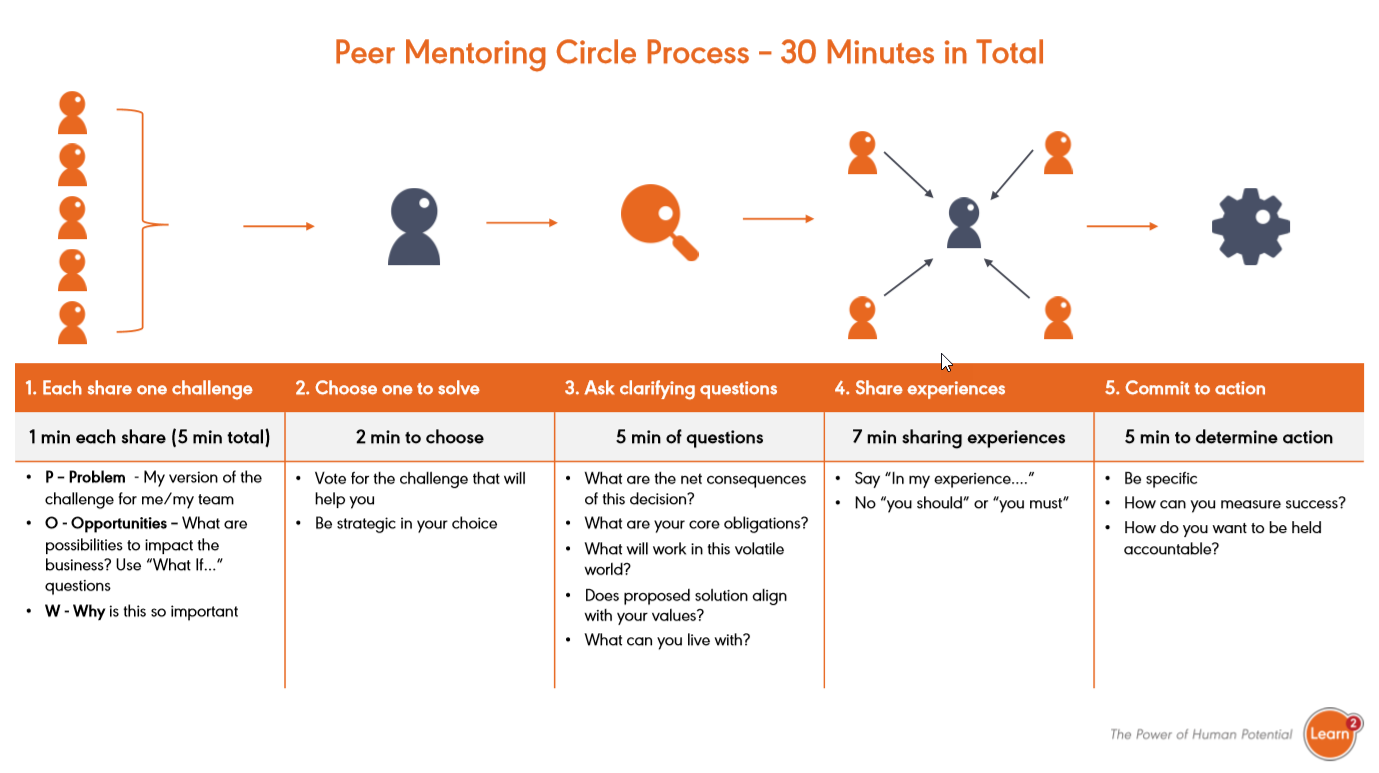
Resources to help you lead your own BrainTrust
Videos
Get to know this tool better
Resource
Tools for You and Your Team

FAQ
WHEN DO I RUN A BRAINTRUST?
Anytime you have a challenge. And anytime you want to enhance collaboration with a team, peers, and leaders. Because BrainTrusts are meant to be fast, you can engage others anytime you want ways to move through a challenge. You can focus on a single challenge or as part of monthly meetings to engage your team to tackle larger departmental challenges.
WHAT TYPES OF BRAINTRUSTS COULD I LEAD?
Start with your leaders or your team to strengthen relationships and commitment to solving challenges. Your team will appreciate your support to remove their challenges. Practicing with your team gets you comfortable. Then encourage your leaders and teams to engage their teams. For your team you can choose challenges or opportunities. For sales teams, both can be exponentially valuable.
Then gather peers together. Peer BrainTrusts are incredibly valuable as you gain an understanding of your peers’ greatest challenges or opportunities. Together you choose which increases alignment. Then together you share lived experience to solve a peer’s challenge. Many peers want to gather monthly to get updated on accountabilities because all leaders have a vested interest in the action plan getting implemented AND benefit from the business impact caused by solving challenges. Again peers want to gather monthly to solve another challenge while being upskilled through everyone’s lived experience.
Then consider stakeholders. Customers thrive and rapidly develop trust when engaging in BrainTrusts. Deep insights in your stakeholders’ worlds improve prioritization, deployment of resources and planning. BrainTrusts deliver massive benefit to you and others. Frequently these lead to larger opportunities like client advisory boards where you can benefit from our facilitation experience and results show 97.4% retention of key accounts.
And remember personal opportunities. We encourage application of learning and we count personal application as being equally valuable on the path to mastery. Personal BrainTrusts range from more formal settings like the parents council at a school, to siblings connecting or families exploring both challenges and opportunities.
YOUR QUESTIONS MATTER TO US, YOUR PEERS AND YOU
We want your questions! All these questions come from you, our participants. We’ll answer your question so please click on the chatbot and ask us anything. Your question helps us and other leaders get clear on what’s required to move from learning to the performance environment. Ask a question now… please.
WHO DO I INVITE TO A BRAINTRUST?
A diverse group helps. Ideally you bring in leaders and team members from different departments and backgrounds. This gives you more experience. BrainTrusts take advantage of mental diversity. People solve problems in different ways, their unique experience sheds new light on the challenge. Challenge yourself to invite those normally outside your sphere. Great leaders leverage BrainTrusts to engage peers across teams and business units as they learn about everyone’s world and find ways forward that benefit everyone.
HOW LONG DO DIFFERENT TYPES OF BRAINTRUSTS TAKE?
30 minutes when you follow the timing. Consider 45 for the first one so you have time to explain the steps. Typically 40 minutes as all the participants get rapidly upskilled and do not want to stop sharing and learning. Team ones take 45 minutes to an hour – because groups of 5-6 go to breakout rooms then everyone comes back in 30 to 45 minutes for a larger report back. While sales teams thrive inside 30 minutes. When you know the challenge in advance, you still share the impact of the challenge from your perspective, then target the root causes or largest shared impact. We still recommend keeping to 45 minutes to keep “story” to a minimum so leaders and teams learn to consistently achieve an accountable action plan in 45 minutes. Leaving time for bio breaks before the next scheduled appointment.
AS A LEADER SHOULD I RUN THEM MYSELF?
You can! In fact, practice the first couple of BrainTrusts with your team to get a feel for how they are conducted. Then encourage your team to run their own – lead them to engage their teams. You’ll find they come up with their own solutions to challenges they used to have to bring to you to solve. You’ll get stronger leaders with stronger teams, which frees up time to concentrate proactively on business priorities.
HOW DO I INITIATE THE FIRST BRAINTRUST?
1. Open with a POW. If POW is new to you or its been a while:
Problem – Focus on their world and acknowledge with acknowledgement statements… You all have worked together to solve all kinds of challenges like… You’ve also collaborated to seize opportunities like… You know we all face challenges finding the time to get proactive on our work toward…
Opportunity – Focus on the benefits with “What if… questions” from their perspective. What if we could all understand each others day-to-day challenges better? What if we could all share our lived experience to support one of us solving a challenge? What if that led to us all leading to support each other more and made our operation smooth so we had more time to plan get proactive? What if that meant that we created fewer challenges for each other and made our day-to-day experience of work better?
What/Why – Use what to introduce the BrainTrust. Use why to explain the challenge or opportunity if you are focusing the BrainTrust on one thing. Then ask an open question like “How could us sharing our challenges then everyone sharing a brain to solve one of those challenges impact our team?”
2. Walk through the steps – Take 30 seconds to a minute MAX on each step. Avoid investing too much time describing what it is like. Invest the time in the shared experience.
3. Ask “What questions do you have?” Don’t ask if people have questions because they won’t say. Ask after each step or at the end.
4. Clarify your role. Either be the facilitator and time keeper or be the participant. Either way make sure someone watches the time if your participants are likely to have a meeting right after.
Start. Avoid too much explanation. Focus your time on getting started.
Reinforce timelines and what to do at every step.
Praise all contributions and provide feedback like: Great challenge and next time keep the description under a minute. Great share and next time focus less on the story and more on the insight. Thank you for contributing and remember that we avoid telling people what we would do or shoulding on people – we really focus on sharing our lived experience. This is because we all rapidly upskill by learning from everyone’s experience not just based on the challenge selected.
